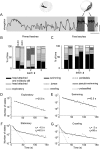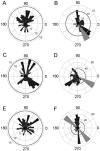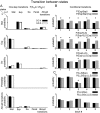Statistics of decision making in the leech
- PMID: 15758170
- PMCID: PMC6725187
- DOI: 10.1523/JNEUROSCI.3808-04.2005
Statistics of decision making in the leech
Abstract
Animals continuously decide among different behaviors, but, even in invertebrates, the mechanisms underlying choice and decision are unknown. In this article, leech spontaneous behavior was tracked and quantified for up to 12 h. We obtained a statistical characterization, in space and time domains, of the decision processes underlying selection of behavior in the leech. We found that the spatial distribution of leech position in a uniform environment is isotropic (the same in all directions), but this isotropy is broken in the presence of localized external stimuli. In the time domain, transitions among behaviors can be described by a Markov process, the structure of which (allowed states and transitions) is highly conserved across individuals. Finally, a wide range of recurrent, deterministic motifs was identified in the apparently irregular and unstructured exploratory behavior. These results provide a rigorous description of the inner dynamics that control the spontaneous and continuous flow of behavioral decisions in the leech.
Figures








Similar articles
-
Development of swimming in the medicinal leech, the gradual acquisition of a behavior.J Comp Physiol A Neuroethol Sens Neural Behav Physiol. 2005 Sep;191(9):813-21. doi: 10.1007/s00359-005-0003-7. Epub 2005 Sep 13. J Comp Physiol A Neuroethol Sens Neural Behav Physiol. 2005. PMID: 16001183
-
Spontaneous electrical activity and behavior in the leech hirudo medicinalis.Front Integr Neurosci. 2007 Nov 30;1:8. doi: 10.3389/neuro.07.008.2007. eCollection 2007. Front Integr Neurosci. 2007. PMID: 18958236 Free PMC article.
-
Quantitative characterization and classification of leech behavior.J Neurophysiol. 2005 Jan;93(1):580-93. doi: 10.1152/jn.00608.2004. Epub 2004 Aug 18. J Neurophysiol. 2005. PMID: 15317841
-
Hematopoietic cell formation in leech wound healing.Curr Pharm Des. 2006;12(24):3033-41. doi: 10.2174/138161206777947443. Curr Pharm Des. 2006. PMID: 16918432 Review.
-
[Leech hirudo medicinalis: a therapeutic alternative available in Mexico].Rev Med Inst Mex Seguro Soc. 2009 May-Jun;47(3):335-40. Rev Med Inst Mex Seguro Soc. 2009. PMID: 20141667 Review. Spanish.
Cited by
-
A passive, camera-based head-tracking system for real-time, three-dimensional estimation of head position and orientation in rodents.J Neurophysiol. 2019 Dec 1;122(6):2220-2242. doi: 10.1152/jn.00301.2019. Epub 2019 Sep 25. J Neurophysiol. 2019. PMID: 31553687 Free PMC article.
-
The dynamics of group formation among leeches.Front Physiol. 2012 May 17;3:133. doi: 10.3389/fphys.2012.00133. eCollection 2012. Front Physiol. 2012. PMID: 22629247 Free PMC article.
-
Calcineurin and protein kinase G regulate C. elegans behavioral quiescence during locomotion in liquid.BMC Genet. 2010 Jan 27;11:7. doi: 10.1186/1471-2156-11-7. BMC Genet. 2010. PMID: 20105303 Free PMC article.
-
Cellular substrates of action selection: a cluster of higher-order descending neurons shapes body posture and locomotion.J Comp Physiol A Neuroethol Sens Neural Behav Physiol. 2008 May;194(5):469-81. doi: 10.1007/s00359-008-0319-1. Epub 2008 Feb 23. J Comp Physiol A Neuroethol Sens Neural Behav Physiol. 2008. PMID: 18297289
-
The use of dendrograms to describe the electrical activity of motoneurons underlying behaviors in leeches.Front Integr Neurosci. 2013 Sep 27;7:69. doi: 10.3389/fnint.2013.00069. eCollection 2013. Front Integr Neurosci. 2013. PMID: 24098274 Free PMC article.
References
-
- Baader AP, Kristan Jr WB (1992) Monitoring neuronal activity during discrete behaviors: a crawling, swimming and shortening device for tethered leeches. J Neurosci Methods 43: 215-223. - PubMed
-
- Barraclough DJ, Conroy ML, Lee D (2004) Prefrontal cortex and decision making in a mixed-strategy game. Nat Neurosci 7: 404-410. - PubMed
-
- Bennett MV (1997) Gap junctions as electrical synapses. J Neurocytol 26: 349-366. - PubMed
-
- Bennett MV (2000) Electrical synapses, a personal perspective (or history). Brain Res Brain Res Rev 32: 16-28. - PubMed
-
- Berg HC (1993) Random walks in biology. Princeton: Princeton UP.
Publication types
MeSH terms
LinkOut - more resources
Full Text Sources
